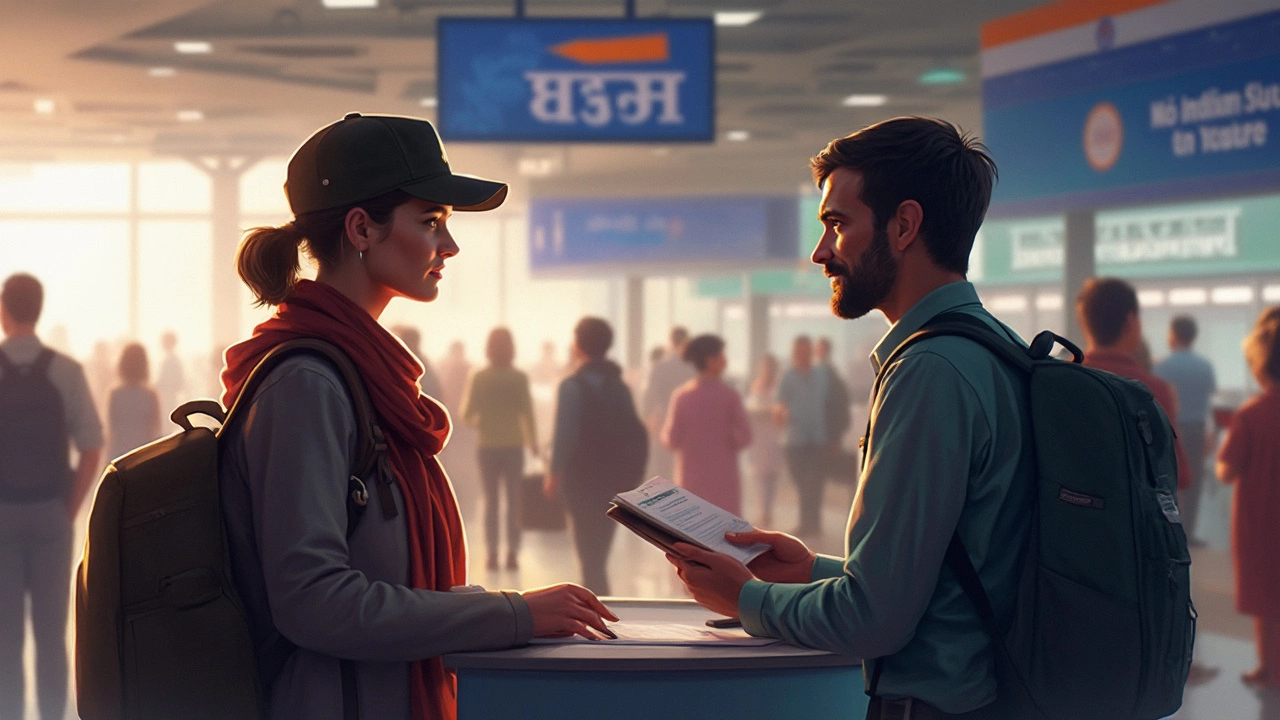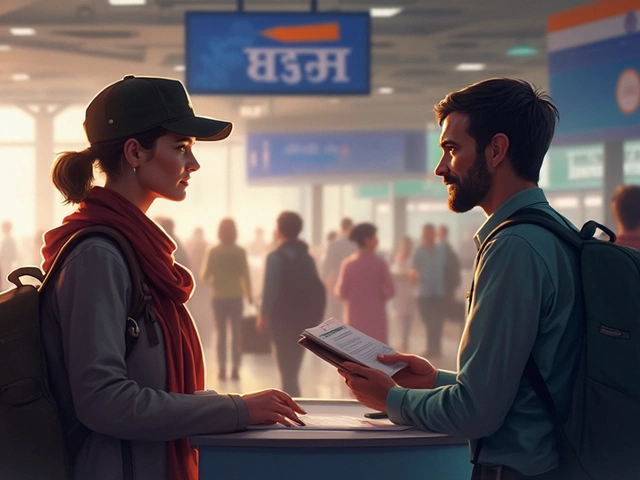If you're a US citizen looking at a long stay in India—maybe for business, maybe to just soak up the place—you've probably wondered how long you can legally hang around without an OCI card. The rules are pretty clear, but the details can sneak up on you if you're not paying attention.
If you don't have an OCI (Overseas Citizen of India) status, you're going to need a visa. For most people, that's either a tourist visa or a business visa. Tourist visas usually get you up to 180 days per visit, but don't assume you can just come and go as you please; you might run into trouble with back-to-back stays. Business visas can sometimes get you up to a year or more, but here's the catch: even then, most require you to leave every 180 days for a quick exit and reentry.
Skipping the OCI option means more hoops: stricter limits, sudden paperwork, surprise questions at the airport. Planning to do this more than once a year? It's time to start thinking about tracking your days like they're dollar bills. Trust me, it's not something you want to mess up—overstaying can mean fines, deportations, and headaches if you're planning anything business-related.
- Visa Types for US Citizens
- Time Limits: How Long You Can Stay
- What Happens If You Overstay
- Tips to Smooth Out Your Long-Term Plans
Visa Types for US Citizens
If you're a US citizen planning a trip to India, choosing the right visa makes all the difference. Without an OCI, you’ll likely go for one of three main options: tourist visa, business visa, or employment visa. Each one comes with different rules and stay limits.
- Tourist Visa: This is by far the most common. For US citizens, you can get a tourist visa for six months at a time. You can apply for eVisa (online), which is good for 30 days, one year, or five years, but don’t get too excited—the catch is, each visit can’t be longer than 180 days at a stretch. And no, you can’t work, do business, or even volunteer with a tourist visa.
- Business Visa: Thinking of making deals, building partnerships, or opening shop? The business visa’s your guy. Usually, US business travelers get a 1-year multiple entry visa, but could be given up to 10 years in some cases. Here’s the thing: most of these require you to leave the country every 180 days. You need a letter from your US employer or Indian partner as proof you actually mean business.
- Employment Visa: Planning on working for an Indian company? The employment visa is for you. These visas are tied to your job contract and can last up to five years (or the length of your contract). The paperwork is a bit of a grind: expect background checks, lots of forms, and salary minimums (usually at least $25,000 per year unless you’re in a charity or non-profit role).
Here’s a quick comparison so you don’t lose track:
| Visa Type | Max Length Per Visit | Who It’s For | Notes |
|---|---|---|---|
| Tourist | 180 days | Leisure travelers | No paid work; up to 5-year visa but 180-day stay limit per trip |
| Business | 180 days (then re-entry) | Business activities | Multiple entry; proof of business needed |
| Employment | Contract length (up to 5 yrs) | Working professionals | Sponsorship and contract required |
The US citizen India stay rules can shift if you’re hopping between visa types, so don't assume what works for a tourist visa will fly for business. Filling out the wrong application can set you back weeks. Triple-check your purpose of travel before you apply, and if you’re stuck, talk to the Indian Consulate or Embassy in the States—they see these situations every day.
Time Limits: How Long You Can Stay
Let's cut straight to the facts: if you’re a US citizen without OCI, how long you can stay in India depends on the type of visa you get. Here’s how it breaks down.
India visa requirements are super clear on dates. Tourist visas are usually for 10 years (multiple entry), but each visit maxes out at 180 days. That means you can stay half a year at a stretch, then you have to leave the country. On business visas, you might get 1 year or more, but you still have a limit of 180 days per visit, unless you register with the Foreigners Regional Registration Office (FRRO). If you skip that, plan on a forced exit at the six-month mark.
- Tourist Visa: 180 days max per visit. Zero wiggle room. If you try to play it clever by hopping over to Nepal or Sri Lanka for a weekend, India’s immigration can shut you down if they catch a pattern.
- Business Visa: Valid up to 1 year (sometimes up to 5 years for regulars), but still, 180-day chunks on each entry unless you register with FRRO. After registration, you could potentially stay for the visa's full validity.
Here’s a quick reference in table form:
| Visa Type | Max Stay per Visit | Registration Needed? |
|---|---|---|
| Tourist Visa | 180 days | No |
| Business Visa | 180 days | Yes, for longer stays |
There’s no lazy loophole. Overstaying is taken seriously. You’ll pay a fine—₹30,000 (about $360) for even a single overstay day, and it climbs higher the longer you stay. On top of that, you risk getting blacklisted for future visits.
If business is your main aim and you think you’ll need more than 180 days, FRRO registration is your golden ticket. But the catch? FRRO paperwork takes time and patience, and your sponsor in India (usually a company, not a person) needs to back you up with the right documents.
In short, unless you snag an OCI, the 180-day per visit cap is non-negotiable. Play by the rules, set reminders, and don’t get greedy with your days in-country. It’s not worth the trouble if immigration flags you down at departure.

What Happens If You Overstay
Overstaying your visa in India isn’t something you want to play with. The Indian authorities take it seriously, and the penalties can ruin your plans in a flash. If you’re a US citizen in India without OCI status, here’s what’s actually on the table if you don’t stick to your allowed time.
- Fines: If you overstay—even by a day—you’ll usually get hit with a penalty. As of 2025, the basic fine starts at $30 for the first 15 days, and it can go up to $500 or even more for longer periods. You’ll pay these at the Foreigner Regional Registration Office (FRRO) before leaving.
- Detention or Deportation: For serious or repeat overstays, you might not just get a fine. Immigration can detain you and start deportation. That's an expensive and embarrassing way to end your stay.
- Ban on Re-entry: Overstayers can get banned from re-entering India for several years. It's not a slap on the wrist—you could be locked out for five or even ten years.
- Impact on Future Visas: Overstaying puts a black mark on your record. If you plan to apply for Indian visas or even other countries’ visas later, it’s going to be tough. Lots of consulates share this information.
The Indian government logs and reports stats on foreigner visa issues. Here’s what it looks like for recent years:
| Year | US Citizens Overstaying (Reported Cases) | Penalties Imposed (USD) | Re-entry Ban Cases |
|---|---|---|---|
| 2023 | 1,425 | $215,000 | 178 |
| 2024 | 1,860 | $295,000 | 209 |
If you realize too late that you’ve overstayed, don’t try to sneak out or hide. Head straight to the nearest FRRO office, be honest, and pay whatever you owe. It might not be pleasant, but trying to dodge the system will make things worse.
Tips to Smooth Out Your Long-Term Plans
If you want to spend more time in India without running into problems, you need a good game plan. Rules are strict about how long you can stay, so don't risk it by guessing or assuming things work like they do in some other countries. Here’s what actually works if you're planning trips for business or other reasons.
- Track your days carefully: Most US citizens aren’t allowed to stay longer than 180 days at a stretch on a tourist visa. Forgetting to count even a single day can cause you big trouble later. Set up calendar reminders for exit dates, or use a free travel tracking app.
- Pick the right visa: If you’re traveling for meetings, setting up a company, or networking, get a business visa. The Indian business visa usually allows multiple entries and can be valid for up to 5-10 years, but it still limits you to 180-day stretches unless you get special permission.
- Don’t overstay: Overstaying your visa—even by one day—can land you fines, travel bans, or even jail time in India. Renew or exit the country on time. The penalty for overstaying is $30 for each day up to a certain limit, and then it can escalate fast.
- Plan for quick border runs: A lot of long-timers do a quick hop to a nearby country (like Nepal or Sri Lanka) before re-entering India to reset their visa clock. Be careful, though—immigration officers sometimes see repeat patterns and can start asking questions or refuse reentry.
- Consult a reliable legal expert: Visa laws and business regulations can change without warning. Find a trusted visa consultant or immigration attorney in India and check in with them before making any long-term commitments or investments.
Here’s a quick look at typical US citizen India stay visa limits and fees, so you know what to expect:
| Visa Type | Max Stay per Visit | Typical Validity | Overstay Penalty (per day) |
|---|---|---|---|
| Tourist Visa (e-Visa) | 180 days | 1 year, multiple entries | $30 |
| Business Visa | 180 days (unless registered with FRRO) | Up to 5 or 10 years, multiple entries | $30, escalates if heavily overdue |
| Conference Visa | 30 days | Single entry | $30 |
One more thing—if you want to keep coming back to India for business, you might want to apply for an OCI in the long run. It’s a bit of an upfront hassle but makes travel and business much easier for US citizens.

